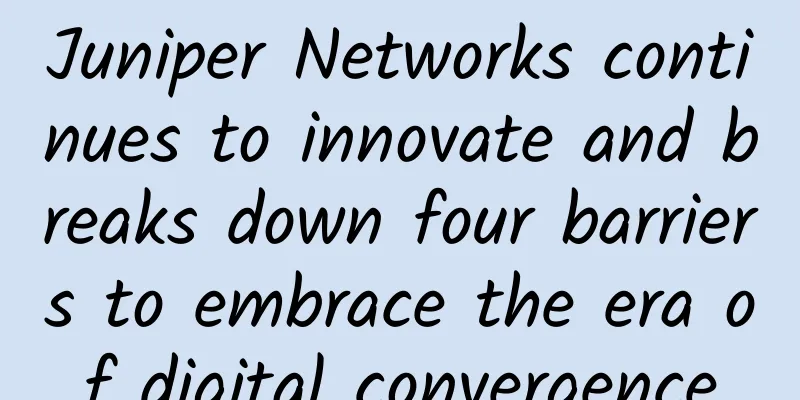Juniper Networks continues to innovate and breaks down four barriers to embrace the era of digital convergence

|
[51CTO.com original article] The 2017 Juniper Networks Innovation Forum was held in Beijing on June 2. Perhaps because Children's Day had just passed, Norman Lam, President of Juniper Networks Greater China, said in his opening speech that the IT industry is a young industry. Although Juniper Networks has been in the IT industry for 20 years, it still has the mentality of a child who dares to think, dares to do, and is creative. Juniper Networks Global CEO Rami Rahim also described the future of the IT industry from a child's perspective. In his speech, he said that if children walk into a supermarket with VR glasses, the supermarket will become different. Children can participate in a game - how to buy a dinner for the family under a fixed budget, and must meet the specified amount of nutrients. Obviously, this is learning through experience, rather than learning by rote in the classroom. "If we can integrate all the knowledge of augmented reality to help children achieve an immersive learning atmosphere and experience, it will be the best gift we can give to children." In fact, the situation described by Rami Rahim is not too far away from us. Embracing the digital convergence era In the medical industry, people have begun to use smart technology to manage patient health, medical records, and monitor patient conditions. In the financial industry, cloud computing, the Internet, and big data are refreshing traditional applications and helping people make better decisions. In the retail industry, Amazon uses artificial intelligence technology and IoT sensors to help buyers achieve a seamless shopping experience online and in physical stores...
Rami Rahim emphasized that all the changes mean a new era - the "digital aggregation" era is coming. He pointed out that in this era, services will become more comprehensive and automated; and as people's acceptance and adaptation to new technologies accelerate, many new technologies will subvert traditional industries. In addition, cloud services have made many impossibilities possible, and people have higher requirements for cost-effectiveness. Horizontal development breaks four major barriers So when will the era of "digital convergence" really be integrated into our lives? Rami Rahim believes that two major constraints must be resolved first: network computing speed and storage. He explained that the user experience depends on the performance of the product, and in performance, how to quickly process, calculate and store is the key. In fact, before the arrival of the digital aggregation era, there are four major barriers in the IT industry that need to be given sufficient attention, because with the rapid development of IT technology, they will soon be broken. First, how to break the curse of Moore's Law? "In the past 20 years, Juniper Networks has been innovating around network speed, storage and customer applications." He pointed out that from the perspective of the entire industry, vertical development has almost reached an extreme, and Juniper Networks began to think about how to provide better applications through horizontal development. "Juniper Networks designed SDN through underlying design and some hardware and physical methods, achieving all-round development from the physical network to overcome the slowdown of Moore's Law." Secondly, do not look at automation with a fearful attitude, but try to understand the value of automation. Rami Rahim said in his speech that the economic benefits brought by automation are huge, and the trend of replacing manual labor is inevitable. Automation can help humans save time and spend more time on self-innovation. He introduced that Juniper Networks is the leader in the field of automation, using programmability to promote the development of the industry. In the future, Juniper Networks will also use various modern technologies including machine learning and big data analysis to build a more effective network, an adaptive network, a resilient network, and a predictive network. Thirdly, in the era of digital convergence, interoperability is a big challenge. In order to provide customers with better performance and services, interoperability is needed from the application layer to the network layer. Juniper Networks hopes to break down barriers at different levels and allow customers to obtain truly effective *** packet automation without sacrificing interoperability. ***The barriers of trust need to be broken. We must admit that the security of existing networks is far from meeting future needs. Current security is feasible within a certain range, and it is not secure enough outside of that range. In the era of digital aggregation, it is necessary to ensure that every part of the entire network is secure enough to keep pace with the overall network security level, not just relatively secure in areas covered by firewalls. Juniper Networks proposed the SDSN solution, which transforms threats from unknown to known, and works with clouds, firewalls, controllers, and switches to form a very secure network. Two dimensions of network innovation When asked by reporters what Juniper Networks innovations were in 2017 compared to last year, Rami Rahim said that Juniper Networks' innovations have two dimensions: The first is to improve the dimension and performance of network expansion. He told reporters that since 2016, Juniper Networks has launched a group of new products around the data center switch market, hoping to extend the length of the entire IP network through this product. Another dimension is automation. Juniper Networks meets greater customer needs through automation, while also making its own services more agile and reaching end users faster. In addition, Juniper Networks also improves cost-effectiveness and manages large and complex devices and networks. He gave an example and told reporters that Juniper Networks launched a machine learning platform product that can provide better solutions for network and cloud services, helping them to better utilize existing resources in the network. It not only optimizes network operations, but also ensures that cloud services never go down, bringing very good performance to end users. In the interview with ***, Rami Rahim concluded that Juniper Networks' ongoing innovation is very exciting, not only because Juniper Networks is participating in building the future, but also because Juniper Networks has the opportunity to influence and change the world in which human beings live, so that its innovative achievements can benefit everyone. [51CTO original article, please indicate the original author and source as 51CTO.com when reprinting on partner sites] |
<<: Six tips to help you choose the best responsive design framework
Recommend
What are the technical difficulties in implementing a multi-person collaborative online document?
This is a long-awaited answer. It just so happens...
[Black Friday] ReliableSite: $55/month-AMD Ryzen5600X/64G memory/512GB NVMe/1Gbps unlimited traffic/Los Angeles and other data centers
ReliableSite has released some special Black Frid...
Smart Home: Which One Wins, 5G or WiFi 6?
Smart homes are becoming an increasingly importan...
Foreign media: South Korea encourages virtual network operators to participate in 5G competition
South Korea's Ministry of Information and Com...
Operators implement unlimited packages. Netizens: Old users and dogs are not allowed to apply
The "speed up and reduce fees" policy h...
Cool down the false millimeter wave! Adhere to the road of confidence and look at the millimeter wave rationally
Last year, a manufacturer raised a very interesti...
Top 10 edge computing vendors to watch
Due to advances in the Internet of Things (IoT) a...
Inside ViaWest's innovative, ultra-secure data centers
The entrance to ViaWest's data center in Chas...
Ele.me Cheng Yanling: Share the correct way to open the era of multi-active operation and maintenance of the whole site
[51CTO.com original article] On December 1-2, 201...
Prefabricated Data Centers – Winning Edge Data Centers
Speed is critical for data. Data is being gener...
Digital-vm 35% off all VPS starting from $2.6/month, 1-10Gbps bandwidth, KVM architecture, 8 data centers in the United States/Japan/Singapore
Digital-vm is a foreign VPS service provider esta...
7 bond modes of Linux multi-NIC
Linux multi-NIC bonding There are seven network c...
Have you ever thought about why TCP needs to handshake before sending data?
When I look at computer networks, there is always...
Hot Topic | Why is the United States determined to "kill" Huawei?
"After reading the 20,000-word interview wit...
Three major dilemmas of big data
【51CTO.com Quick Translation】 Big data, as a set ...









